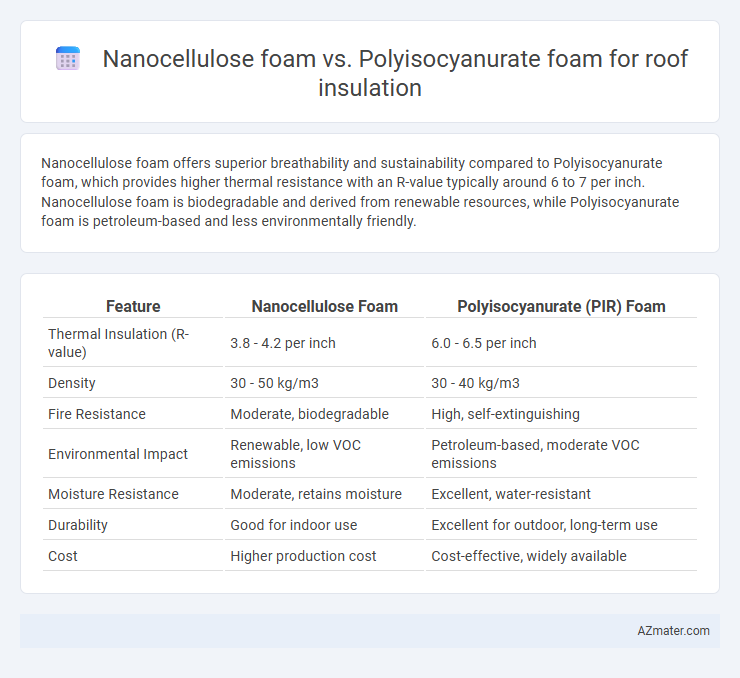Nanocellulose foam offers superior breathability and sustainability compared to Polyisocyanurate foam, which provides higher thermal resistance with an R-value typically around 6 to 7 per inch. Nanocellulose foam is biodegradable and derived from renewable resources, while Polyisocyanurate foam is petroleum-based and less environmentally friendly.
Table of Comparison
| Feature | Nanocellulose Foam | Polyisocyanurate (PIR) Foam |
|---|---|---|
| Thermal Insulation (R-value) | 3.8 - 4.2 per inch | 6.0 - 6.5 per inch |
| Density | 30 - 50 kg/m3 | 30 - 40 kg/m3 |
| Fire Resistance | Moderate, biodegradable | High, self-extinguishing |
| Environmental Impact | Renewable, low VOC emissions | Petroleum-based, moderate VOC emissions |
| Moisture Resistance | Moderate, retains moisture | Excellent, water-resistant |
| Durability | Good for indoor use | Excellent for outdoor, long-term use |
| Cost | Higher production cost | Cost-effective, widely available |
Introduction to Roof Insulation Materials
Nanocellulose foam offers a sustainable, biodegradable alternative with excellent thermal resistance and moisture regulation for roof insulation. Polyisocyanurate foam, a widely used rigid insulation material, provides high R-values and exceptional fire resistance due to its closed-cell structure. Both materials enhance energy efficiency, but nanocellulose foam excels in environmental impact, while polyisocyanurate foam dominates in structural strength and long-term durability.
What is Nanocellulose Foam?
Nanocellulose foam is an innovative insulation material derived from cellulose fibers extracted from wood pulp or plant matter, featuring a lightweight and porous structure that offers excellent thermal insulation and sound absorption properties. Compared to polyisocyanurate foam, nanocellulose foam is biodegradable, non-toxic, and has superior moisture regulation capabilities, reducing the risk of mold growth in roof insulation applications. Its renewable origin and lower environmental impact make nanocellulose foam a sustainable alternative for energy-efficient and eco-friendly roof insulation solutions.
Understanding Polyisocyanurate Foam
Polyisocyanurate foam (PIR) is a rigid, closed-cell insulation material widely used in roof insulation due to its high thermal resistance and fire-retardant properties, with an R-value typically ranging between 6 and 6.5 per inch. This foam, derived from polymerized MDI (methylene diphenyl diisocyanate) and polyols, offers superior moisture resistance and dimensional stability compared to other foam insulations. Its lightweight nature and ease of installation make PIR a cost-effective and energy-efficient solution for both commercial and residential roofing systems.
Thermal Performance Comparison
Nanocellulose foam exhibits superior thermal insulation properties with a low thermal conductivity typically around 0.02 W/m*K, enhancing energy efficiency in roofing applications. Polyisocyanurate foam, renowned for its high R-value per inch (approximately 6 to 6.5), offers excellent resistance to heat transfer but may degrade under prolonged UV exposure. Comparing both, nanocellulose foam provides sustainable and eco-friendly thermal performance, while polyisocyanurate delivers robust thermal resistance with established long-term durability in roof insulation systems.
Environmental Impact and Sustainability
Nanocellulose foam offers superior environmental benefits compared to polyisocyanurate foam due to its renewable biomass origin and biodegradability, significantly reducing landfill waste and carbon footprint. Polyisocyanurate foam, derived from petroleum-based chemicals, contributes to greenhouse gas emissions and poses challenges in recycling and disposal, impacting long-term sustainability negatively. Choosing nanocellulose foam supports circular economy principles by promoting resource efficiency and minimizing ecological toxicity in roof insulation applications.
Fire Resistance and Safety Analysis
Nanocellulose foam demonstrates superior fire resistance compared to polyisocyanurate foam due to its natural, non-toxic composition and lower smoke toxicity during combustion. Polyisocyanurate foam, while offering high thermal insulation performance, tends to release hazardous gases such as hydrogen cyanide and produces dense smoke when exposed to fire, raising safety concerns. Safety analysis indicates nanocellulose foam reduces fire hazards and toxic fume emissions, making it a safer option for roof insulation under stringent fire code requirements.
Moisture Resistance and Durability
Nanocellulose foam exhibits superior moisture resistance due to its hydrophobic treatment, reducing water absorption and preventing mold growth in roof insulation applications. Polyisocyanurate foam offers excellent thermal insulation but is more susceptible to moisture ingress, which can degrade its structural integrity over time. Durability-wise, nanocellulose foam maintains stability under fluctuating humidity conditions, while polyisocyanurate requires protective barriers to sustain long-term performance against moisture-related deterioration.
Installation Process and Practicality
Nanocellulose foam offers a lightweight, flexible installation process that can be sprayed or poured into roof cavities, ensuring excellent coverage and reduced waste compared to rigid Polyisocyanurate foam boards, which require precise cutting and fitting. Polyisocyanurate foam provides higher thermal resistance (R-value around 6-6.5 per inch) but is less adaptable to irregular roof shapes, making installation more labor-intensive and time-consuming. Nanocellulose foam's biodegradability and moisture-regulating properties enhance long-term practicality in roof insulation systems, whereas Polyisocyanurate foam boasts superior fire resistance and durability under high temperatures.
Cost Effectiveness and Market Availability
Nanocellulose foam offers a sustainable alternative with moderate thermal insulation and increasing market availability but tends to have higher initial costs compared to traditional foams. Polyisocyanurate foam provides superior thermal performance with a higher R-value per inch, making it more cost-effective for long-term energy savings and widely available in commercial roofing markets. Cost effectiveness of polyisocyanurate foam is supported by its established supply chain and proven durability, whereas nanocellulose foam's market presence is growing but remains limited and more niche.
Future Prospects and Innovations in Roof Insulation
Nanocellulose foam exhibits promising future prospects due to its biodegradability, superior thermal insulation properties, and potential for enhanced fire resistance through innovative additives, positioning it as an eco-friendly alternative to traditional materials. Polyisocyanurate foam remains a benchmark for high thermal performance and structural strength but faces challenges related to environmental impact and sustainability, driving research towards bio-based polyisocyanurate formulations and improved recyclability. Ongoing innovations in nanotechnology and green chemistry are expected to accelerate the development of both materials, enhancing energy efficiency and sustainability in roof insulation solutions.

Infographic: Nanocellulose foam vs Polyisocyanurate foam for Roof insulation
 azmater.com
azmater.com